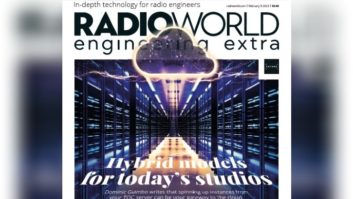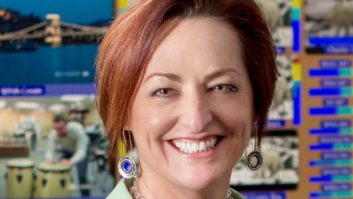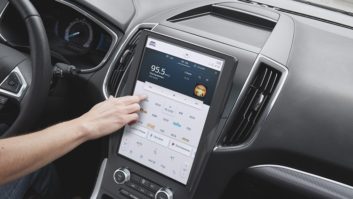During the past 10 years, the use of RDS in FM radio receivers has increased tremendously.
Nevertheless, specifically among European public broadcasters, there is an increasing attitude that FM and RDS are “dead and buried,” they are “not alive and kicking” any longer. We, however, think that in spite of their age — FM radio is now over 60 years old and RDS is more than 25 — in combination, both remain very attractive and totally mature radio broadcast technologies that cannot be easily replaced by digital radio.
When the RDS Forum came into being in 1993, it was comprised mainly broadcasters, and there were only a few major car radio manufacturers in the forum. Nowadays it is the opposite; the Forum consists of mostly industry members and there are only a few broadcasters left.
However, to get the best out of RDS, both are needed. It is the well known “chicken and egg” relationship, which needs to be fully understood in the RDS context. We need more broadcasters to join our forum and will now explain the benefits to them.

Figure 1: RT+ is now in use in Germany. MANY EXPERTS
In the RDS Forum we have many experts, who can contribute to raising the awareness of the broadcasters about what RDS still has to offer. We are not talking about the basic RDS features that are used everywhere these days, but about dynamic program-related RDS features, which are still much under-used.
Manufacturers in the RDS Forum are very quick to add features to RDS radios, if these are needed in the market, but we can only develop this together with an alliance of broadcasters and manufacturers. Remember, we, in the RDS Forum, have the eggs, but we need the chicken!
We feel that the RDS technology is firmly established nowadays within the industry, and for FM radio broadcasters it still has many attractions to offer, particularly in the mobile environment.
In the years 2005 to 2008 the RDS specification was totally updated by the RDS Forum and the new version of the RDS standard was published in August 2009 with the reference IEC 62106:2009 Ed.2 and containing some new RDS-Open Data Application (ODA) features: RadioText Plus (RT+) and enhanced RadioText (eRT).
The use of the ODA means in RDS that the new feature is backwards compatible with old receivers. Any new RDS-ODA feature will not disturb them, as it cannot be decoded. But new ODA features can then be used by newly designed receivers that intend to implement them.
There are not yet many receivers on the market that support RT+, simply because the market is not yet big enough. However, in the United States broadcasters are increasingly using RadioText Plus to “tag” music titles and artist names.
Since September 2009, the Apple iPod nano (5G) has an RDS FM radio incorporated and it has the RT+ feature implemented as well, so that it can display music title and artist name information.
In Germany, the public broadcasters implement RT+ increasingly. Up to now 12 regional FM programs already use RadioText Plus. (See Figure 1.)
In the United States — Clear Channel Radio — a former RDS Forum Member, has implemented RadioText Plus nationwide since 2008, which in effect creates an important market there. The trend is already being followed by several other radio broadcaster groups.
The RDS product market has indeed developed over the time since RDS was first launched by the industry in 1987 and shows significant market development as seen in the year-by-year graph. (See Figure 2.)
Some small portable RDS devices also transmit in FM short-range audio and RDS data to the car audio system, e.g., MP3 music — an application covered by the newly updated RDS specification.
In 2008, the RDS Forum agreed to such an implementation option in order to avoid industry outside the forum using RDS for this particular application in an uncontrolled manner.
CORRECT USAGE
When RDS Forum Members exchange their experience about RDS, one important issue which comes up, is the correct usage of RDS.
Sometimes corrective action by the broadcasters can be taken with quick success. Often the manufacturers within the RDS Forum take the initiative to point out what is wrong with some of the signals on air. The listener will only blame the product maker and not the broadcaster, if something is working incorrectly.

Figure 2: Year-by-Year Growth for RDS Adoption The RDS Forum carries out work to also raise the awareness of broadcasters. This is done to encourage them to use RDS for FM broadcasting in the best possible manner for the benefit of their listeners.
Broadcasters could also benefit from the observations made by the industry members of the RDS Forum who want their products to work correctly in response to the RDS features put on air by the broadcasters and also explore the dynamic features specified in RDS.
Yet, the listener is the final target. We want everything to work smoothly and correctly. The chicken and egg relationship is important.
Broadcasters and manufacturers should communicate, about implementations — as RDS is very important and is fundamental for a well functioning FM radio.
In March 2009, RDS turned 25 — not the RDS Forum, which started only in 1993, but the RDS specification, published by the European Broadcasting Union in March 1984.
RDS has been and still is a “silent revolution” and not all broadcasters are fully aware of its success.
Nowadays, almost 25 years after that technology was created, nearly all FM radios use RDS. ICs have become available that have an FM receiver and an RDS decoder on the same chip and the price for such a chip, if bought in quantities, is now extremely low. The trend of this price is still falling and the quantity of such chips sold on the world market is still increasing, now more than 200 million units per year.
Many applications of RDS are already within mobile phones and portable network devices. The more traditional car radios may still have a separate RDS decoder IC, but nowadays RDS decoding is often also an integral part of a dedicated multipurpose DSP, necessary for the product even without RDS. In these products the RDS functional price is then almost zero, as it is done in software only.
LONG LIFE
In Europe, at least, it was actually RDS that made FM broadcasting very successful and extremely widespread. Thus RDS technology will live as long as FM broadcasting does, and the RDS Forum can see no obvious end date emerging, despite the switch-off policies now much talked about by regulators.
Radio listening is still a very popular activity — everyone listens to the radio on average two to three hours per day. It is entertaining and a secondary activity so that the listener can do other things while being entertained, which is not always the case for television.
When the EBU held its Forecast conference in November 2009, the spectrum planning experts present were not yet in a position to predict a date for a changeover from analog to digital radio.
The question was also asked there to the broadcasters present, about who had already plans for switching off FM. Surprisingly there was almost nobody present to confirm that this will happen soon, except the representative of Danmarks Radio. The BBC has a strong interest to support the official U.K. FM switch-off policy for 2015, but only if by then 98 percent of all the national radio listening will be on DAB. Now, in the United Kingdom it is only less than 30 percent in the homes and almost none in the cars.
There are doubts among the experts, that a change-over to digital radio listening in Europe will happen within the next years and certainly not before 2020, or so. Thus, if we are still to use FM for another 10 to 15 years, our question is: “Why then not offer FM radio at its best?” By this we mean all the features that RDS can offer. For example, as described earlier, RadioText Plus — now part of the updated RDS specification.
When RDS was in its infancy, there were few data links between studios and transmitters, but with the onset of digital radio and the Internet these exist in many broadcasters’ stations today, so it is easy to do dynamic RDS program features.
It is our view that FM and digital radio will co-exist still for a long period of time.
Up to now, digital radio (DAB) has been successful, for example, in the United Kingdom. From the 12 or 13 million DAB radios sold in the 15 years since DAB started, 10 million were sold in the U.K. and 2 million of those during 2009. Almost all of these radios have also FM and RDS, too. In the United Kingdom alone, there are about 200 million radios, so imagine how long it will take to replace them in that country, where digital radio is already a big success. Elsewhere it will inevitably take much longer!
In addition it will be very expensive to achieve coverage of the less densely populated parts of a country. Who will pay to build the infrastructure needed? It will take thus very many additional years to achieve it.
FM–DIGITAL RADIO LINK
It will be essential for a successful introduction and roll-out of digital radio, that a solid and reliable linking mechanism between FM and digital radio is established. This will most probably be necessary for a period of 10 to 15 years. The RDS Forum wants to contribute to develop this.
What we mean by this is the following:
For a driver leaving the coverage area of an FM radio program the signal will change first from stereo to mono. At a later stage, noise will become stronger and interference may come up, but then — the program remains audible and the driver will choose the moment to select a different radio program.
For digital radio however, this behavior is completely different. The audio quality can be excellent and at one moment later the radio is muted. There is hardly anything between a full stereo audio signal and complete silence.
Then it is essential, if the same radio program is still available on FM, that such a gap is filled by FM rather than to leave the driver with silence.
In the current financial climate, most broadcasters are very short of money for capital investment. However, because they already have the RDS encoders and the data delivery infrastructure, they could enhance their FM broadcasts for comparatively little cost.
One colleague from the Dutch public broadcaster NPO told us that digital radio did not yet sell well in his country. Therefore his broadcast colleagues invest now heavily into FM and RDS.
Probably they are not the only country, where this should be done now.
Therefore, it looks as if FM broadcasting will still have a long future — and therefore let us see that FM radio works well with RDS and its powerful program related features.
In addition, a well conceived linkage concept may well support a smooth introduction of digital radio, specifically in cars, and then the natural transition to digital radio will be helped as well.
Dietmar Kopitz is CEO of the RDS Forum Office, Johnny Beerling is chairman of the RDS Forum, and Bev Marks is an honorary member of the RDS Forum. The authors can be contacted through the RDS Forum Web site, www.rds.org.uk.












